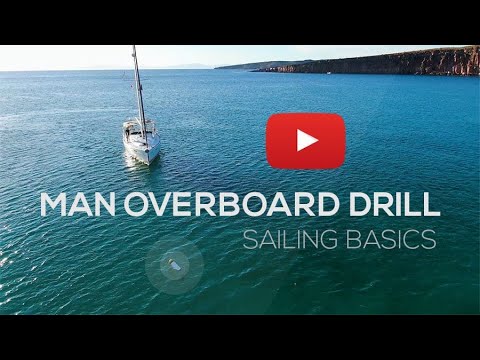Nou în navigație? Am creat această serie cuprinzătoare de videoclipuri de navigație de bază doar pentru tine! Știm cât de dificil este să găsești răspunsuri solide la întrebările tale legate de fundamentele navigației. În calitate de instructori profesioniști de navigație, înțelegem acest lucru și, deoarece tratam aceste subiecte în mod regulat cu studenții noștri, știam că vă putem ajuta și pe dvs. Am creat aceste videoclipuri Aflați cum să navigați: Noțiunile de bază ale navigației, pentru a fi seria dvs. finală de videoclipuri cu navigație 101. În ele, acoperim navigația cu monococă pentru începători, de la ancorare, până la trepte pentru recuperarea unui bărbat peste bord, până la aranjarea perfectă a velei! În acest videoclip, vom acoperi: Drill Man Overboard (cunoscut și sub numele de Drill Crew Overboard). Acest videoclip vă arată cel mai eficient mod de a vă aduce membrul echipajului înapoi la bord. 00:00 Bumper 00:31 Crew Overboard Drill introducere 01:36 Primul lucru când cineva cade peste bord, strigă! 01:45 Punct! Asigură-te că cârmaciul te poate vedea, ține ochii pe persoana din apă 02:17 Cât de repede pierzi din vedere pe cineva care cade peste bord 02:41 Aruncă! Aruncați un inel de salvare, o geamandură sau un alt dispozitiv MOB persoanei aflate în direcția vântului 02:52 Porniți motoarele dacă sunteți sub vela 03:00 Aruncați pânzele și înfășurați cât de repede puteți 03:10 Motor 3-5 lungimi de barcă în aval de vânt echipajul în apă 03:30 Întoarceți-vă în vânt și aliniați-vă folosind steaguri sau alte instrumente 03:45 turație mai mică a motorului pentru a merge la ralanti înainte – încetiniți 04:09 Țintește-le direct pe aceeași parte cu cârma 04:20 Accesați lungimi neutre de 1-2 bărci din COB Vizualizați playlistul complet pentru seria de videoclipuri Learn How To Sail: Sailing Basics aici: https://www.youtube.com/playlist?list=PL0joRZMH7HDTHJlZGAzlUGgboKEmHylMI Sperăm să vă placă și vă mulțumim pentru vizionarea! PS. Vrei să petreci o săptămână pentru a-ți îmbunătăți abilitățile de navigare în timp ce locuiești la bordul unui iaht frumos într-o locație exotică? Vizitați Nautilus Sailing School: https://www.nautilussailing.com/ #learntosail #howtosail #sailingbasics #sailing101 #beginningsailing #sailing #sailboat
source
How To Sail: Man Overboard Drill – Seria video de bază despre navigație





Pepe? Not Chuck or Mitch? Did you pick him up a home depot to sand your teak and he found your liquor cabinet. Other than that good info.
S/B Man overboard from a motorboat.
more than one minute to get to the substance
Step 1…do not rely on your motor! Step 2…practice when there is a good wind. Step 3 do not move any farther from the MOB than absolutely necessary…you may be the only one on the boat. Step 4 do not tell anyone there is only one way to do something.
Came for the drill. Stayed for the mild racism.
I appreciate these simple videos, but cringed when I saw your overboard dummy in this one. Kinda racist.
It supossed to be a body mock up well njoy the rides 80 years from now. The storm is approaching and…
Obviously there is more than one way to do most anything on a sailboat. There's the figure 8 method, the Quick Stop method, motoring, plus others. A lot depends on the situation, crew, motor/no motor, weather, seas, experience. I'm taking ASA sailing classes, but I enjoy and appreciate learning wherever good information can be found, so thank you Nautilus Sailing for the video.
Holy cow, why not just do a figure-eight with all your sales up install the boat out right on top of them? Takes a fraction of the time. And you're less likely to lose them in a chopper swell
Just a heads up. I share this with my crew but have to warn them about the limited, and somewhat racist view of Mexicans.
Great overview of the technique. I would revise the racist assumptions about who is our person to be rescued.
Insanely racist man overboard buoy…
LOL the comments… if it was racist they would have let Pedro drown! PS. Hispanic is not a race!
Learn how to Sail: "turn on your engine and get down your sails as fast as possible". 😌
I have taught ASA Classes for several years at several ASA affiliate schools, and taught US/Sailing at one school. I have taught the FIgure-8, BRCR, and Quickstop methods at all of them. The secret that few instructors divulge is that COB drills are really about learning boat handling. This video presents the most accurate instruction of how to handle a real COB situation.
When I teach COB, I tell students that we are going to pretend that there is no working engine aboard. However, I also tell them that if this were a REAL COB, and you have inexperienced sailors aboard, start the engine and drop the sails. Stop the engine when you have made contact with the COB and are about to begin retrieval.
Sailing 4-5 boat lengths away from the COB, tacking, steering 2 boat lengths to windward of the COB, crossing your wake, and then turning to windward, as in the Figure-8, takes too much time. If you miss the COB on your first attempt, then you have to sail around again, and that takes more time. Time is something that you do not have in an emergency.
Thank you for this video!
I am occasional, amateur skipper (mostly inland day sailing). I sometimes take on inexperienced crew. I found that running a bit of training before taking off and doing one or couple man overboard drills goes a long way relieving tension, feeling them safer and setting them to have fun time. And I admit, the same goes for me – every successful man overboard drill gives me that little important boost of confidence.
As to Pepe, for him to behave a little more realistically I tie to him 5L jug filled with sand and water. People in water cannot be taken on board while traveling at any speed. I also don't take most easy to spot thing so that people get how important it is to keep the eye on the person.
As to starting the engine, I think you always have to start the engine but frequently it is much faster to complete the manoeuvre under sail. Especially if you have a puny overboard engine like I have that sometimes isn't enough to overcome the wind. If I trust the crew to drop the sail quickly at exact point I need them I will assign one person to start the engine but otherwise complete the manoeuvre under sail. If I am not sure of the crew I will get one tack done at a distance that will give me a bit of time for them to drop the sail and I will complete it using just the engine.
I would also complete it using just the engine if I have very small crew so that I have somebody ready to receive man over board and not busy with handling the sail (remember, I am steering, somebody is an Eye, somebody is starting/handling the engine, two people are needed to handle sails effectively… that's already quite resource intensive operation).
As to recovering at the beam – on most boats of that size it is impossible to recover an actual human at the beam. And not sure what that boathook is supposed to accomplish. Use it as a harpoon so the person can't swim away? I would be worried to have a crew member to wave a hook close to a person in the water because of possibility for injury and because it is not entirely clear what to do afterwards. Additionally, if there is any SNAFU with sails, the bow might not be a safe place to be in in the first place. I think the training should reflect a realistic situation as much as possible and the crew should know how to take on a realistic person and on that kind of yacht it will inevitably happen at the stern.
Another reason to do it at the stern is that I, the skipper, have perfect view of what is happening and that makes it easier to make decisions and/or directly help with the effort.
You cover a whole about sailing and safety, you should make videos and sale it too.
Terminology, sail and mast type, wind formation,tools must have and etc. I hope so!
Thank you for your gift of knowledge and sharing
experiences.
👍💟☮️
Crew overboard? Do you have a video for Man Overboard like the title of the video?
The racism destroyed this whole video for me.
Hi Guys,
Great video's for a starting Sailer like me!
Getting the unconscious 100kg mob back in strikes me as the harder part of the rescue. Especially as it's probably only me on board. I've tried using a spare main halyard to winch them in, but it really needs two people. Rescue sling?
I really disagree with this process. I believe some people will die if they follow this process. A simple crash tack will bring a sailing vessel upwind of the mob and immediately into irons, or at least halt the vessel from leaving the scene further. Easing the headsail for sailing back to the mob or stay in irons and allow the mob to swim to the vessel as it drifts down upon them. Some sailing yachts require a lot of time to drop sails. Starting your engine in an emergency might just pick up a rope causing the vessel to be disabled itself, making matters exponentially worse. A solution that works both in calm seas or offshore in 50knots works best in my mind. Yachtmaster Offshore with approx 30,000hrs give or take. Practice and tell me I'm wrong or right.